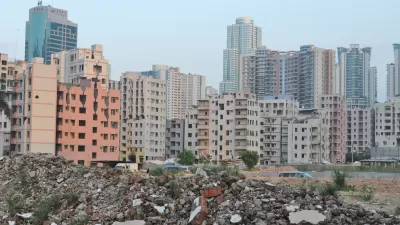Minneapolis is, by many accounts, home to a thriving economy. Why then, are there so many vacant properties in the city?
"Nearly 340 residential buildings sit empty and boarded across Minneapolis, despite a severe housing shortage and a steep vacant property fee that has raised $20 million for city services over the past decade," reports Andy Mannix.
The number of vacant properties has declined by half since the height of the Great Recession and Foreclosure Crisis, according to Mannix, but the remaining vacancies are proving particularly obstinate.
According to Mannix, the persistence of these vacant properties works contrary to every manner of market pressure. The city charges the owners of vacant properties $7,000 a year in fees, the housing market is tighter than it's been in decades, and the foreclosure rate in Minneapolis is one of the lowest in the country.
The article explores, in a lot more detail, why vacant property owners keep paying the fee, what services the fee pays for, and why the city is motivated to improve vacant properties.
FULL STORY: Minneapolis still battling against vacant properties -- even in housing shortage

Alabama: Trump Terminates Settlements for Black Communities Harmed By Raw Sewage
Trump deemed the landmark civil rights agreement “illegal DEI and environmental justice policy.”

Study: Maui’s Plan to Convert Vacation Rentals to Long-Term Housing Could Cause Nearly $1 Billion Economic Loss
The plan would reduce visitor accommodation by 25% resulting in 1,900 jobs lost.

Why Should We Subsidize Public Transportation?
Many public transit agencies face financial stress due to rising costs, declining fare revenue, and declining subsidies. Transit advocates must provide a strong business case for increasing public transit funding.

Paris Bike Boom Leads to Steep Drop in Air Pollution
The French city’s air quality has improved dramatically in the past 20 years, coinciding with a growth in cycling.

Why Housing Costs More to Build in California Than in Texas
Hard costs like labor and materials combined with ‘soft’ costs such as permitting make building in the San Francisco Bay Area almost three times as costly as in Texas cities.

San Diego County Sees a Rise in Urban Coyotes
San Diego County experiences a rise in urban coyotes, as sightings become prevalent throughout its urban neighbourhoods and surrounding areas.
Urban Design for Planners 1: Software Tools
This six-course series explores essential urban design concepts using open source software and equips planners with the tools they need to participate fully in the urban design process.
Planning for Universal Design
Learn the tools for implementing Universal Design in planning regulations.
Smith Gee Studio
Alamo Area Metropolitan Planning Organization
City of Santa Clarita
Institute for Housing and Urban Development Studies (IHS)
City of Grandview
Harvard GSD Executive Education
Toledo-Lucas County Plan Commissions
Salt Lake City
NYU Wagner Graduate School of Public Service




























